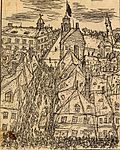Potemkin village
| Tell me about your mother Psychology |
| For our next session... |
| Popping into your mind |
A Potemkin Village (sometimes called a propaganda village) is any construction, ranging from a façade up to full towns, built for the purpose of deceiving visitors into believing that the local situation is better than it actually is.
A favorite of Communist and Nazi regimes alike, a Potemkin village is, in effect, a vehicle of psychological warfare against those who would suspect that things might in fact not be hunky-dorey for those living under an authoritarian heel.
Origin[edit]
The term dates to 1787; the story goes that the Russian statesman Grigory Potyomkin![]() tasked with governing New Russia (recently-conquered lands in present-day Ukraine), had a fake portable settlement built to impress the visiting empress, Catherine the Great.[1]
tasked with governing New Russia (recently-conquered lands in present-day Ukraine), had a fake portable settlement built to impress the visiting empress, Catherine the Great.[1]
Modern historians largely believe that the original Potemkin-village story is a myth, but the term has persisted to describe genuine examples of deceptive settlements and other structures.
Examples[edit]
- Enron constructed a fake trading floor, complete with actors and rehearsals, for the purpose of duping analysts.[2]
- Kijŏng-dong (Korean: "Peace Village"; 평화리) is a Potemkin village in North Korea, within the 4km wide DMZ. As a result of a petty flagpole-building contest with South Korea, by far the most notable set piece within the actual village is its 160m high flagpole.[3] Despite the original intention for the village, some of the buildings have seemingly fallen into disrepair, removing whatever remaining propaganda value the structures had.
- Theresienstadt was a hybrid ghetto-and-concentration Camp used during the Holocaust. Of the 144,000 Jews who were sent to Theresienstadt, 121,000 died. Thirty-three thousand died from the conditions of the camp itself, and another 88,000 after being relocated to other camps. Despite this, in 1944 the Nazis planned to deceive the Red Cross
 by cleaning up the camp and using Theresienstadt as a model internment camp, a deception that somehow partially succeeded.[4][5] As a follow-up to this deceit, the Nazis also produced a propaganda film at the location, with Jewish prisoner Kurt Gerron as the director.[6] As "compensation" for his services, he was deported to Auschwitz upon completion of the film.[7]
by cleaning up the camp and using Theresienstadt as a model internment camp, a deception that somehow partially succeeded.[4][5] As a follow-up to this deceit, the Nazis also produced a propaganda film at the location, with Jewish prisoner Kurt Gerron as the director.[6] As "compensation" for his services, he was deported to Auschwitz upon completion of the film.[7]
Images of Theresienstadt[edit]
Facades for the International Commission, by Bedřich Fritta (c. 1943-1944)[8]
Ghetto: View of the Divided Street (Lange Straße), by Bedřich Fritta (c. 1943-1944)[8]
See also[edit]
References[edit]
- ↑ Straight Dope — Did "Potemkin villages" really exist
- ↑ "Enron 'sting' used fake command centre", The Guardian
- ↑ "Korea’s no-man’s-land", Salon
- ↑ P. Boder Interviews Friedrich Schlaefrig
- ↑ Famous Red Cross Visit to Theresienstadt Theresienstadt History (Archive.org from November 22, 2012)
- ↑ Theresienstadt: Ein Dokumentarfilm aus dem jüdischen Siedlungsgebiet (Terezin: A Documentary Film from the Jewish Settlement Area), also known as Der Führer Schenkt Den Juden Eine Stadt (The Führer Gives the Jews a City) A surviving fragment of the film
- ↑ Gerron
- ↑ 8.0 8.1 Bedřich Fritta: Drawings from the Theresienstadt Ghetto, 17 May to 29 September 2013, and as part of the special program on the Terezín Ghetto from 28 February to 4 May 2014








